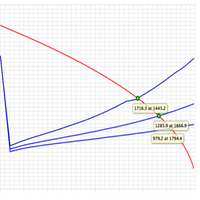Category: PQplot
Contents
Brief
PQplot is the core petroleum engineering engine of the pengtools.
PQplot calculates inflow performance relationship IPR and vertical lift performance VLP curves for oil and gas wells.
PQplot is available online at www.pengtools.com and in AppStore for iPad.
Typical applications
- Calculating the Nodal Analysis [1] model of the well
- Matching the Nodal Analysis model to the well test data
- Exporting the VLP tables to Excel or reservoir simulator
- Estimation of well's Production Potential and AOF
- Tubing sizing
- Selection of the operating wellhead pressures
- Estimation of the effects of reservoir pressure depletion
- Sensitivity studies
Main features
- Plot of Inflow performance curve IPR and Vertical lift performance curve VLP
- Rate and pressure at intersection point
- Sensitivity analysis of IPR and VLP curves on parameters
- Using prepared PVT models
- Inclined wells calculations
- Tubing, annular and both flow types
Interface features
- Save and share references to saved models with colleagues
- Last saved model on current computer and browser is automatically opened
- Choose between Metric units and US oilfield units
- Save as image and print plot by means of chart context menu (button at the upper-right corner of chart)
- Download report in pdf format containing input parameters, calculated values and plot
- Select and copy results to Excel or other application
Correlations
| Type of problem | Correlation | Reference |
|---|---|---|
|
Oil well VLP |
Hagedorn, A. R., & Brown, K. E. (1965). Experimental study of pressure gradients occurring during continuous two-phase flow in small-diameter vertical conduits. Journal of Petroleum Technology, 17(04), 475-484. | |
|
Gas well VLP |
Gray, H. E. (1974). Vertical flow correlation in gas wells. User manual for API14B, subsurface controlled safety valve sizing computer program. | |
|
Dry gas VLP |
Cullender, M.H. and Smith, R.V. 1956. Practical Solution of Gas-Flow Equations for Wells and Pipelines with Large Temperature Gradients. Trans., AIME 207: 281. | |
|
Oil well inflow |
Composite IPR based – Vogel equations taking into account water |
Kermit E. Brown "The Technology of Artificial Lift Methods" Vol. 4 Production Optimization of Oil and Gas Wells by Nodal System Analysis, p. 30, section 2.227.1 |
|
Gas well inflow – backpressure equation |
Rawlins and Schellhardt |
Rawlins, E.L. and Schellhardt, M.A. 1935. Backpressure Data on Natural Gas Wells and Their Application to Production Practices, Vol. 7. Monograph Series, USBM. |
|
Gas well inflow – pseudo-pressure equation using Jd and kh values |
Real-gas pseudopressure equation |
See for example: Ahmed, T., & McKinney, P. (2011). Advanced reservoir engineering. Gulf Professional Publishing. |
|
Turner |
Turner, R. G., Hubbard, M. G., and Dukler, A. E. (1969) “Analysis and Prediction of Minimum Flow Rate for the Continuous Removal of Liquids from Gas Wells,” Journal of Petroleum Technology, Nov. 1969. pp. 1475–1482. | |
|
Guidelines from API RP14E |
Mokhatab S, Poe WA, Speight JG (2006) "Handbook of Natural Gas Transmission and Processing", Section 11.6 - Design Considerations on sales gas pipelines, subsection 11.6.1 - Line Sizing Criteria, Elsevier, 2006. |
PVT correlations are the same as in PVT tool.
References
- ↑ Mach, Joe; Proano, Eduardo; E. Brown, Kermit (1979). "A Nodal Approach For Applying Systems Analysis To The Flowing And Artificial Lift Oil Or Gas Well"
 (SPE-8025-MS). Society of Petroleum Engineers.
(SPE-8025-MS). Society of Petroleum Engineers.
Pages in category "PQplot"
The following 13 pages are in this category, out of 13 total.

